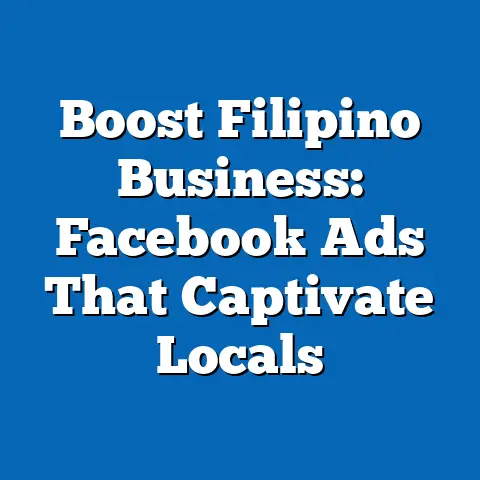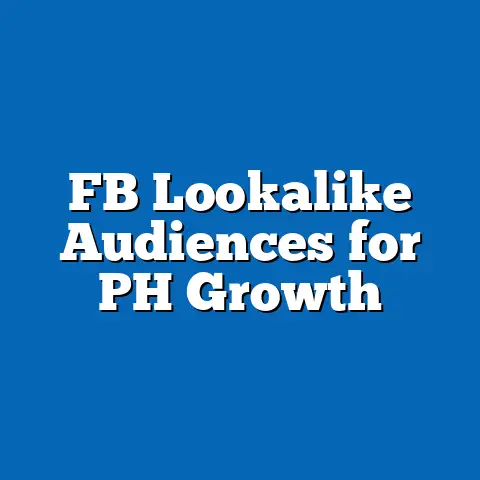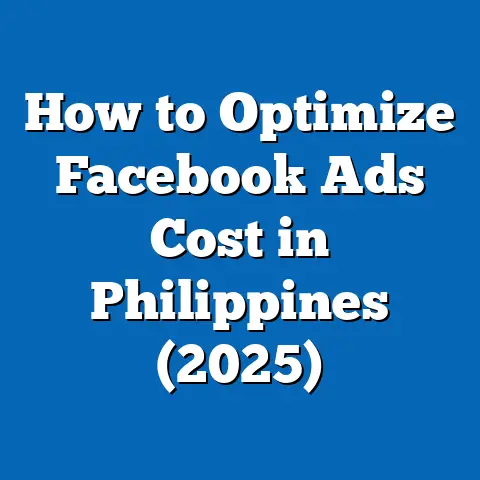Philippines’s Facebook Ads Cost: What You Need to Know!
Philippines’s Facebook Ads Cost: What You Need to Know!
Introduction: The Art and Science of Facebook Advertising in the Philippines
When I first started exploring Facebook advertising, I was immediately drawn by how visually enticing ads could stop a busy Filipino scrolling through their feed. Just like how a colorful jeepney or a festive street scene grabs attention in the streets of Manila, a well-designed Facebook ad—bold images, lively colors, catchy taglines—can make people pause and engage. But behind those captivating visuals lies a more critical element—understanding how much it costs to run these ads and how to get the best bang for your peso.
Facebook advertising has grown from being the playground of big brands into a vital tool for small sari-sari stores in Barangay Poblacion, local eateries in Davao, and online sellers in Cebu. The Philippines, with its 80+ million active Facebook users, offers a massive audience hungry for products and services. But many local businesses get overwhelmed by questions like, “How much should I budget?” or “Why are my ads so expensive compared to others?”
In this guide, I’ll walk you through everything you need to understand about Facebook Ads costs in the Philippines—from basic concepts to detailed strategies that I’ve learned firsthand from running campaigns for Filipino SMBs. Whether you’re just starting or want to deepen your knowledge, this guide will give you data-backed insights and practical steps to succeed.
Why Facebook Advertising is a Game-Changer for Filipino Businesses
The Filipino Social Media Landscape
Facebook is king in the Philippines—70% of Filipinos are active on the platform daily. It’s where people chat with friends, watch videos, shop online, and discover new brands. For local businesses, this makes Facebook advertising an unmatched way to:
- Reach your exact audience by location (down to the city or province)
- Target specific age groups and interests
- Engage users with content that feels familiar and local
- Measure results instantly and tweak campaigns on the fly
Advantages Over Traditional Advertising
Traditional marketing channels like TV or print media can cost lakas-ng-balat (a ton of money) but lack precise targeting. With Facebook Ads, you can spend as little as ₱50 a day and still reach thousands of people who are more likely to be interested in your product.
Breaking Down Key Facebook Ads Terms
Before we discuss costs in detail, let me explain some essential terms I use often:
| Term | Simple Explanation |
|---|---|
| CPM (Cost Per Mille) | Cost to show your ad 1,000 times. |
| CPC (Cost Per Click) | Cost every time someone clicks your ad. |
| CTR (Click-Through Rate) | Percentage of viewers who click your ad after seeing it. |
| Ad Relevance Score | A score from 1 to 10 showing how relevant your ad is to your audience. |
| Pixel | A small code snippet you place on your website to track actions from ads. |
| Campaign Objective | What you want your ad to do: raise awareness, get clicks, or generate sales. |
Understanding these helps you interpret how Facebook charges you and how effective your ads are.
What Factors Affect Facebook Ads Cost in the Philippines?
Facebook Ads don’t have fixed prices like buying space on TV. Instead, costs vary based on several factors:
1. Bidding Model
You can either let Facebook automatically bid for you or set a manual maximum bid. Automatic bidding uses Facebook’s algorithms to get you the most results at the lowest cost. Manual bidding gives you more control but requires experience.
2. Audience Size and Competition
Targeting a small but highly competitive group (e.g., “moms in Metro Manila who like baby products”) usually means higher costs because advertisers compete for the same eyeballs.
3. Ad Placement
Facebook lets you place ads across different spots:
- Facebook News Feed
- Instagram Feed
- Stories (Facebook & Instagram)
- Messenger
- Audience Network (partner apps)
Some placements cost more due to higher engagement rates.
4. Ad Quality and Relevance
Ads that resonate well with your audience have higher relevance scores and cost less per engagement.
5. Campaign Objective
Conversions (like sales) usually cost more than awareness campaigns because they require stronger calls-to-action and better targeting.
6. Timing and Seasonality
During peak seasons like Christmas or important holidays like Araw ng Kalayaan, ad costs spike due to increased demand.
Typical Facebook Ads Costs in the Philippines: Data & Insights
Based on my experience managing campaigns for Filipino SMBs and industry reports from 2023–2024, here’s what you can expect:
| Metric | Average Cost Range (PHP) | Notes |
|---|---|---|
| CPM | ₱50 – ₱120 | Lower during off-peak months; higher during holidays |
| CPC | ₱3 – ₱15 | Depends on industry; e-commerce usually higher |
| Cost per Lead | ₱20 – ₱100 | For lead generation campaigns |
| Cost per Conversion | ₱50 – ₱200 | Varies widely based on product price and offer quality |
For example, a food delivery service targeting Metro Manila might see CPM around ₱70 and CPC around ₱8, while an online course targeting professionals may pay over ₱100 CPM due to niche targeting.
Step-by-Step Guide: Launching Cost-Effective Facebook Ads in the Philippines
Step 1: Choose Your Campaign Objective Wisely
Your campaign’s objective determines how Facebook optimizes your ads and how much you pay.
Common objectives include:
- Brand Awareness: Show ads to as many people as possible.
- Traffic: Drive users to your website or app.
- Engagement: Boost likes, shares, comments.
- Leads: Collect contact info.
- Conversions: Get purchases or sign-ups.
From my experience, businesses new to Facebook should start with brand awareness or engagement campaigns because they cost less and build an audience foundation before pushing sales.
Step 2: Define Your Target Audience Using Local Insights
Facebook allows hyper-targeting based on:
- Location: Pinpoint specific cities or even barangays.
- Age & Gender: For example, 18-30-year-old female shoppers.
- Interests: Target Filipino interests like “K-pop,” “Filipino cuisine,” or “TikTok.”
- Behaviors: Such as frequent online shoppers or recent purchasers.
One lesson I learned is that targeting too broadly wastes budget. For instance, if you sell sarisari store goods online, narrowing down your audience to “residents within 10 km radius” reduces wasted impressions.
Step 3: Select Ad Placements Strategically
Auto placements are convenient but not always cost-efficient.
In my campaigns, I found that:
- Facebook Feed usually gives the best balance of engagement and cost.
- Instagram Stories can be effective for younger audiences but may cost more.
- Audience Network sometimes gives low-quality traffic leading to poor conversions.
Try testing different placements with small budgets to identify what works best locally.
Step 4: Set Your Budget and Bidding Strategy
Start with a daily budget that fits your business size. For many Filipino SMBs, ₱200–₱500 daily is a good starting point.
There are two main bidding options:
- Lowest Cost (Automatic): Let Facebook get you as many results as possible within your budget.
- Cost Cap: Set a maximum cost per result you’re willing to pay.
For beginners, I recommend starting with “Lowest Cost” until you gather enough data then experiment with “Cost Cap” for better control.
Step 5: Create Ads That Reflect Filipino Culture and Language
Using local idioms (e.g., “Sugod na!” or “Walang kapantay na saya!”) connects emotionally with your audience.
Visuals matter too—bright colors reminiscent of Filipino fiestas or scenes of family gatherings create familiarity.
Video ads perform well here because Filipinos love video content. Short clips showing product use or customer testimonials can boost engagement dramatically.
Step 6: Install Facebook Pixel on Your Website
Pixel tracks user behavior after clicking your ads — allowing better retargeting and conversion tracking.
If you have an online shop or website, installing pixel is essential for measuring campaign effectiveness and reducing wasted spend.
Step 7: Monitor Campaign Metrics & Optimize Regularly
Key metrics to watch:
- CPM: Is it rising? May indicate increased competition.
- CPC: Are clicks affordable given your budget?
- CTR: Low CTR means ad isn’t engaging.
- Conversion Rate: Are people buying or signing up?
Use this data to pause weak ads, tweak creatives, adjust targeting, or try different bids.
Real Case Studies from Filipino SMBs
Case Study 1: E-commerce Store Cuts CPC by 45%
A Cebu-based online fashion retailer was paying ₱12 per click with broad targeting. I helped narrow their audience to women aged 18-35 interested in Filipino-made clothes and shifted placements mostly to Facebook Feed.
They also added videos showing real customers wearing their products using local slang captions.
After two weeks:
- CPC dropped from ₱12 to ₱6.5
- CTR increased by 30%
- Sales doubled without increasing budget
Case Study 2: Local Restaurant Boosts Conversions by 60%
A family-owned restaurant in Quezon City used brand awareness campaigns during off-season months but struggled with conversions.
I advised them to:
- Use lead generation campaigns offering promos
- Target neighborhoods within 5 km radius
- Use Messenger ads for direct reservations
Conversions rose by 60%, CPM stabilized around ₱55 from ₱90 previously.
Additional Tips for Managing Your Facebook Ads Budget Wisely
- Test Multiple Ad Sets: Run small tests before committing large budgets.
- Use Retargeting: Show ads again to people who engaged but didn’t convert.
- Avoid Ad Fatigue: Refresh creatives every 7–10 days.
- Leverage Lookalike Audiences: Create audiences similar to your best customers.
- Schedule Ads Wisely: Turn off ads during hours when engagement is low.
Dealing with Common Challenges Filipino SMBs Face
Challenge: Limited Marketing Budget
Solution: Focus on narrow targeting and start with brand awareness campaigns costing less than ₱300 daily.
Tip: Use organic posts alongside paid ads to stretch reach without extra cost.
Challenge: Lack of Technical Know-how
Solution: Take advantage of free tutorials from Meta Blueprint or local workshops. Hiring freelancers experienced with Philippine market nuances can also help.
Challenge: Peak Season Price Surges
Solution: Plan campaigns months ahead; start early promotions before costs spike around holidays like Christmas or Fiesta season.
Understanding Metrics That Really Matter
Many get caught up looking at likes or impressions alone — but what counts is ROI (Return on Investment).
Focus on:
- Cost per Acquisition (CPA): How much each sale or lead costs you.
- Conversion Rate: Percentage of clicks resulting in sales.
- Frequency: How often same person sees your ad; too high = ad fatigue.
Tracking these helps avoid spending on ineffective ads.
Advanced Features You Should Know About
- Dynamic Ads: Automatically show relevant products to users based on their browsing behavior.
- Facebook Shops Integration: Sell directly on Facebook without website.
- Automated Rules: Set rules to pause ads if costs rise too high.
- A/B Testing: Test different creatives or audiences side by side for best results.
Many Filipino businesses don’t explore these yet but they provide powerful growth tools once familiar.
Practical Next Steps for Filipino Entrepreneurs Ready to Advertise on Facebook
- Set up Business Manager Account: It centralizes your ad accounts securely.
- Connect Payment Method: Use credit/debit cards or GCash wallets accepted by Facebook.
- Create Your First Campaign: Start small with awareness or engagement objectives.
- Install Pixel on Your Website: Essential for tracking and optimization.
- Join Local Marketing Communities: Groups like “Pinoy Digital Marketers” offer support.
- Keep Learning & Optimizing: Use analytics weekly to improve results continuously.
Conclusion: Making Every Peso Count in Your Facebook Ads Journey
Facebook advertising in the Philippines offers immense opportunities but requires understanding of costs and strategies unique to our market. By learning key terms, setting clear objectives, targeting precisely, creating culturally relevant ads, and optimizing regularly—you can maximize return while controlling costs.
Remember my mantra when running ads here — bawat piso dapat may kwenta (“every peso must count”). Whether you’re selling handmade crafts in Pampanga or offering online tutorials in Iloilo, mastering these skills can help your business thrive online without breaking the bank.
I invite you now to apply these insights—start testing small campaigns today! And if you want personalized help setting up or reviewing your ads, just reach out. Success is just one well-crafted ad away!
Salamat sa pagbabasa! (Thanks for reading!)






